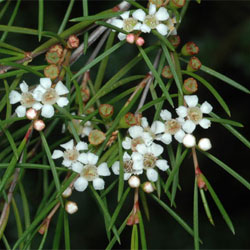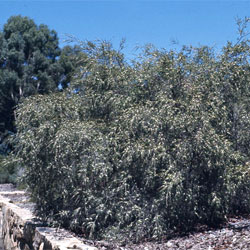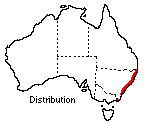Baeckea linifolia
 |
 |
Flax-leaf Heath Myrtle
Flax-leaf Heath Myrtle (Baeckea linifolia) is a delicate weeping shrub from moist habitats in eastern Victoria and New South Wales, conspicuous for its very fine, straight leaves and stems. It has proved tough, however, in growing at the Australian National Botanic Gardens and has survived drought well.
 It
is a useful size for small gardens, remaining at a 2 m tree-like shape and only
bushy at the base if trimmed for that purpose. This is a shrub not for distant
viewing or bold effect but for near planting where the tiny white flowers can
be seen, or a leaf bruised now and then for its spicy perfume.
It
is a useful size for small gardens, remaining at a 2 m tree-like shape and only
bushy at the base if trimmed for that purpose. This is a shrub not for distant
viewing or bold effect but for near planting where the tiny white flowers can
be seen, or a leaf bruised now and then for its spicy perfume.
At the Australian National Botanic Gardens examples can be seen in built-up soil mulched with bark chips, and shaded by tall trees. They survived drought years, though growth was sparse and dull, and recovered when regular watering became possible. Light shade is a definite advantage, protecting the top growth from drying out; no winter protection is needed.
Tip growth on the weeping branches is very free, with narrow, even leaves about 2 cm long. They are smooth and waxy, showing numerous transparent dots (oil glands) when magnified. The foliage of a healthy watered shrub shines, turning purple in winter, an advantage of the cold Canberra climate noted on many species in these Gardens.
The tiny, pure white flowers are a perfect shape, with five petals, and resemble Leptospermum (Tea Trees) to which the genus Baeckea is related. All face upwards on the stems and for their size are quite showy, especially on the purplish background, as one of the best flowering times is June to July. A flush of flowers can occur at any time from early February; in fact they are completely absent only during a short rest from late spring onwards.
The seed capsules are like tiny bells on short stalks and they also turn red in ripening, making this a shrub of changing tints. Capsules brought indoors release numerous fine seeds and these or summer cuttings are used in propagation.
Plants can be obtained from nurseries dealing in native plants and can be planted in most soils as long as they are free from lime and sheltered from drying winds. One attractive use would be in small groups in a lawn, with smaller plants beneath and, as the plant is very flexible, it could be used, trimmed if necessary, among rocks.
If pruned for bushy growth it probably would be tall enough to help in covering a fence - a useful attribute in a new garden. Sprays of cut flowers live well in water, continuing to open and, if desired, cutting can help towards pruning.
Pests and diseases have not been seen, except for some die-back, possibly due to root-rot fungus in water-logged conditions caused by continuous rains. This indicates that, though moisture is needed, drainage must be good.
Based on text by ANBG staff (1973)
Name meaning: Baeckea linifoliaBaeckea - after Dr Abraham Baeck (1713 - 1795), a Swedish physician
and friend of the botanist Linnaeus; |
![An Australian Government Initiative [logo]](/images/austgovt_brown_90px.gif)

